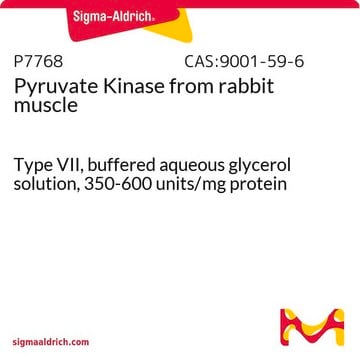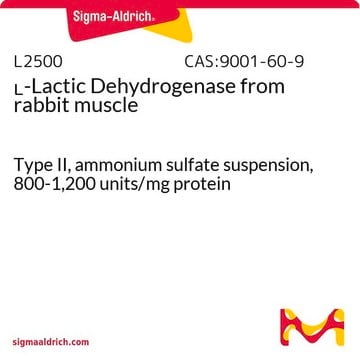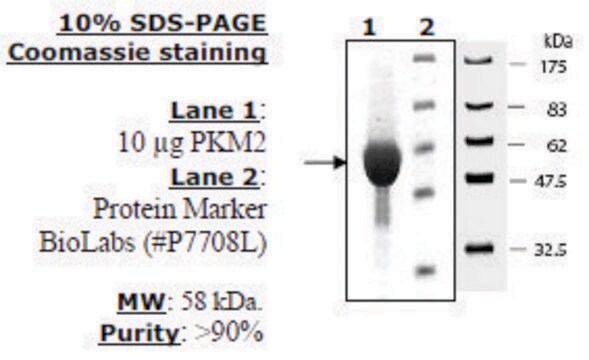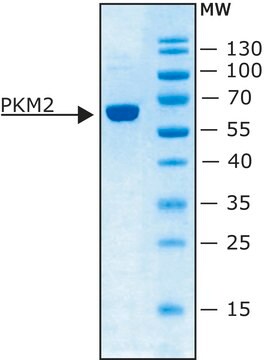The concentration in U/mL can be determined using the Enzymatic Activity and the mg protein/mL value reported on the lot specific Certificate of Analysis. For example, a lot has a reported Enzymatic Activity of 359 units/ mg protein and 13.7 mg protein/ mL will have a concentration 4918.3 units/ml. Please see the link below to review a sample or lot specific Certificate:
https://www.sigmaaldrich.com/US/en/product/sigma/p1506#product-documentation
P1506
Pyruvate Kinase from rabbit muscle
Type II, ammonium sulfate suspension, 350-600 units/mg protein
Synonym(s):
ATP:pyruvate 2-O-phosphotransferase, PK
Select a Size
Select a Size
About This Item
Recommended Products
biological source
rabbit muscle
Quality Level
type
Type II
form
ammonium sulfate suspension
specific activity
350-600 units/mg protein
mol wt
237 kDa
storage condition
(Tightly closed)
technique(s)
ligand binding assay: suitable
color
white
foreign activity
lactic dehydrogenase, creatine phosphokinase, and myokinase ≤0.01%
phosphoglucomutase ≤0.05%
storage temp.
2-8°C
Looking for similar products? Visit Product Comparison Guide
General description
Pyruvate kinase from rabbit muscle catalyzes ATP-dependent phosphorylation of glycolate to yield 2-phosphoglycolate.[1]Pyruvate kinase, an enzyme,[2] is found in a tetrameric or a dimeric form.[3] PKM1, PKM2, PKR, and PKL are the four mammalian pyruvate kinase isoforms.[2]
Application
Biochem/physiol Actions
Isoelectric Point: 7.6
Optimal pH: ∼7.5
Optimal Temperature: 25°C
ΕA280 = 0.54 for 1 mg(p)/ml, 1 cm path
Reported KM values are ATP (0.86 mM), pyruvate (10 mM), ADP (0.3 mM), and PEP (0.07 mM) in Tris buffer at pH 7.4 and 30 °C. Pyruvate kinase is highly specific for phosphoenolpyruvate, but can utilize other dinucleotide triphosphates as substrates in place of ATP including GTP, ITP, dATP, UTP, and CTP.
Unit Definition
Physical form
Analysis Note
Enzyme
Related product
antibody
substrate
Storage Class
12 - Non Combustible Liquids
wgk_germany
WGK 2
flash_point_f
Not applicable
flash_point_c
Not applicable
Choose from one of the most recent versions:
Certificates of Analysis (COA)
Don't see the Right Version?
If you require a particular version, you can look up a specific certificate by the Lot or Batch number.
Already Own This Product?
Find documentation for the products that you have recently purchased in the Document Library.
Customers Also Viewed
Articles
Instructions for working with enzymes supplied as ammonium sulfate suspensions
-
この製品(P1506, ピルビン酸キナーゼ)についてご質問があります。 この製品の比活性は350-600 units/mg proteinと記載ありますが、濃度としてU/mLはお分かりになるのでしょうか。 Lot毎に異なることかもしれませんので、試薬の瓶そのものに記載があったりするのでしょうか(データシートには記載が見当たらない)。 ご確認のほど、よろしくお願いいたします。
1 answer-
Helpful?
-
-
Hi, How long can this be stored in the fridge?
1 answer-
This product is not assigned an expiration date or retest date. Products that are robust in nature and extremely stable, in the original unopened container, are not assigned an expiration date or retest schedule. These products will have no dating reported on either the label or the Certificate of Analysis. Products that are not assigned an expiration or retest date are covered by a warranty period of 1 year from the date of product shipment.
Helpful?
-
Active Filters
Our team of scientists has experience in all areas of research including Life Science, Material Science, Chemical Synthesis, Chromatography, Analytical and many others.
Contact Technical Service












